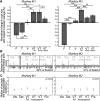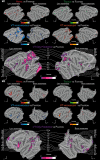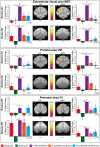The Prediction of Impact of a Looming Stimulus onto the Body Is Subserved by Multisensory Integration Mechanisms
- PMID: 28993482
- PMCID: PMC6596520
- DOI: 10.1523/JNEUROSCI.0610-17.2017
The Prediction of Impact of a Looming Stimulus onto the Body Is Subserved by Multisensory Integration Mechanisms
Abstract
In the jungle, survival is highly correlated with the ability to detect and distinguish between an approaching predator and a putative prey. From an ecological perspective, a predator rapidly approaching its prey is a stronger cue for flight than a slowly moving predator. In the present study, we use functional magnetic resonance imaging in the nonhuman primate, to investigate the neural bases of the prediction of an impact to the body by a looming stimulus, i.e., the neural bases of the interaction between a dynamic visual stimulus approaching the body and its expected consequences onto an independent sensory modality, namely, touch. We identify a core cortical network of occipital, parietal, premotor, and prefrontal areas maximally activated by tactile stimulations presented at the predicted time and location of impact of the looming stimulus on the faces compared with the activations observed for spatially or temporally incongruent tactile and dynamic visual cues. These activations reflect both an active integration of visual and tactile information and of spatial and temporal prediction information. The identified cortical network coincides with a well described multisensory visuotactile convergence and integration network suggested to play a key role in the definition of peripersonal space. These observations are discussed in the context of multisensory integration and spatial, temporal prediction and Bayesian causal inference.SIGNIFICANCE STATEMENT Looming stimuli have a particular ecological relevance as they are expected to come into contact with the body, evoking touch or pain sensations and possibly triggering an approach or escape behavior depending on their identity. Here, we identify the nonhuman primate functional network that is maximally activated by tactile stimulations presented at the predicted time and location of impact of the looming stimulus. Our findings suggest that the integration of spatial and temporal predictive cues possibly rely on the same neural mechanisms that are involved in multisensory integration.
Keywords: fMRI; looming visual; macaque; multisensory integration; prediction; tactile.
Copyright © 2017 the authors 0270-6474/17/3710656-15$15.00/0.
Figures






Similar articles
-
Impact prediction by looming visual stimuli enhances tactile detection.J Neurosci. 2015 Mar 11;35(10):4179-89. doi: 10.1523/JNEUROSCI.3031-14.2015. J Neurosci. 2015. PMID: 25762665 Free PMC article.
-
Multisensory peripersonal space: Visual looming stimuli induce stronger response facilitation to tactile than auditory and visual stimulations.Cortex. 2024 Apr;173:222-233. doi: 10.1016/j.cortex.2024.01.008. Epub 2024 Feb 13. Cortex. 2024. PMID: 38430652
-
Spatiotemporal integration of looming visual and tactile stimuli near the face.Hum Brain Mapp. 2018 May;39(5):2156-2176. doi: 10.1002/hbm.23995. Epub 2018 Feb 6. Hum Brain Mapp. 2018. PMID: 29411461 Free PMC article.
-
Multisensory contributions to the 3-D representation of visuotactile peripersonal space in humans: evidence from the crossmodal congruency task.J Physiol Paris. 2004 Jan-Jun;98(1-3):171-89. doi: 10.1016/j.jphysparis.2004.03.008. J Physiol Paris. 2004. PMID: 15477031 Review.
-
See me, hear me, touch me: multisensory integration in lateral occipital-temporal cortex.Curr Opin Neurobiol. 2005 Apr;15(2):145-53. doi: 10.1016/j.conb.2005.03.011. Curr Opin Neurobiol. 2005. PMID: 15831395 Review.
Cited by
-
Body ownership and the absence of touch: approaching the rubber hand inside and outside peri-hand space.Exp Brain Res. 2018 Dec;236(12):3251-3265. doi: 10.1007/s00221-018-5361-9. Epub 2018 Sep 15. Exp Brain Res. 2018. PMID: 30220004 Free PMC article.
-
Socially meaningful visual context either enhances or inhibits vocalisation processing in the macaque brain.Nat Commun. 2022 Aug 19;13(1):4886. doi: 10.1038/s41467-022-32512-9. Nat Commun. 2022. PMID: 35985995 Free PMC article.
-
When two worlds collide: the influence of an obstacle in peripersonal space on multisensory encoding.Exp Brain Res. 2021 Jun;239(6):1715-1726. doi: 10.1007/s00221-021-06072-1. Epub 2021 Mar 29. Exp Brain Res. 2021. PMID: 33779791 Free PMC article.
-
The relationship between action, social and multisensory spaces.Sci Rep. 2023 Jan 5;13(1):202. doi: 10.1038/s41598-023-27514-6. Sci Rep. 2023. PMID: 36604525 Free PMC article.
-
Peripersonal space in the front, rear, left and right directions for audio-tactile multisensory integration.Sci Rep. 2021 May 28;11(1):11303. doi: 10.1038/s41598-021-90784-5. Sci Rep. 2021. PMID: 34050213 Free PMC article.
References
-
- Avillac M, Olivier E, Denève S, Ben Hamed S, Duhamel JR (2004) Multisensory integration in multiple reference frames in the posterior parietal cortex. Cogn Process 5:159–166. 10.1007/s10339-004-0021-3 - DOI
Publication types
MeSH terms
LinkOut - more resources
Full Text Sources
Other Literature Sources
